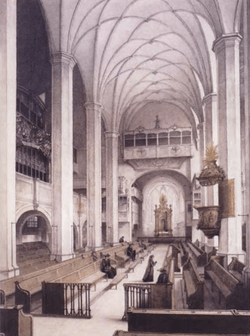Ach Gott, vom Himmel sieh darein, BWV 2
| Ach Gott, vom Himmel sieh darein | |
|---|---|
| BWV 2 | |
| Chorale cantata by J. S. Bach | |
 Thomaskirche, Leipzig 1885 | |
| Occasion | Second Sunday after Trinity |
| Performed | 18 June 1724 – Leipzig |
| Movements | 6 |
| Cantata text | anonymous |
| Chorale | Martin Luther: "Ach Gott, vom Himmel sieh darein" |
| Vocal |
|
| Instrumental |
|
Ach Gott, vom Himmel sieh darein (Oh God, look down from heaven), BWV 2, is a church cantata by Johann Sebastian Bach, composed in Leipzig for the second Sunday after Trinity and first performed on 18 June 1724. It is the second cantata of his second annual cycle of chorale cantatas, and is based on Martin Luther's hymn "Ach Gott, vom Himmel sieh darein", published in 1524 in the first Lutheran hymnal.
History and words
Bach composed the cantata for the Second Sunday after Trinity in Leipzig as the second cantata of his second annual cycle, which began a week before with O Ewigkeit, du Donnerwort, BWV 20.[1][2] The prescribed readings for the Sunday were from the First Epistle of John, "He that loveth not his brother abideth in death" (1 John 3:13–18), and from the Gospel of Luke, the parable of the great banquet (Luke 14:16–24). The cantata is based on the six-stanza chorale Ach Gott, vom Himmel sieh darein, published by Martin Luther in 1524 in the Achtliederbuch, paraphrasing Psalm 12. The words are used unchanged in movements 1 and 6. An unknown poet transcribed the ideas of stanzas 2–5 into recitatives and arias.[1][2] Bach first performed the cantata on 18 June 1724.[1]
Scoring and structure
The work in six movements is scored for three vocal soloists (alto, tenor, and bass), a four-part choir, four trombones, two oboes, two violins, viola, and basso continuo. The trombones play colla parte with the choir.[1]
- Chorus: Ach Gott, vom Himmel sieh darein
- Recitative (tenor, bass): Sie lehren eitel falsche List
- Aria (alto, violin solo): Tilg, o Gott, die Lehren
- Recitative (bass, strings): Die Armen sind verstört
- Aria (tenor): Durchs Feuer wird das Silber rein
- Chorale: Das wollst du, Gott, bewahren rein
Music
In the first and last movements, which use the original words of Luther's hymn, the style of the music is "archaic"—the instruments include a choir of trombones doubling the voices.[2][3] In the first movement the melody of the chorale is sung by the alto in long notes, doubled by two oboes. Each line is prepared by fugal entrances of the other parts on the same theme.[4] The second movement is a secco recitative, changing to arioso for two lines that resemble the words of the chorale, marked adagio. The alto aria is written in "modern" style with a solo violin in lively figuration. The bass recitative is accompanied by the strings. In contrast, the tenor aria is accompanied by a concerto of the oboes and strings, which are silent in the middle section until its transition to the da capo. The closing chorale is a four-part setting.[1]
Recordings
- J.S. Bach: Das Kantatenwerk – Sacred Cantatas Vol. 1, Nikolaus Harnoncourt, Wiener Sängerknaben & Chorus Viennensis, Concentus Musicus Wien, Paul Esswood, Kurt Equiluz, Max van Egmond, Teldec 1971
- Die Bach Kantate Vol. 39, Helmuth Rilling, Gächinger Kantorei, Bach-Collegium Stuttgart, Helen Watts, Aldo Baldin, Walter Heldwein, Hänssler 1979
- J.S. Bach: Complete Cantatas Vol. 10, Ton Koopman, Amsterdam Baroque Orchestra & Choir, Michael Chance, Paul Agnew, Klaus Mertens, Antoine Marchand 1998
- Bach Edition Vol. 12 – Cantatas Vol. 6, Pieter Jan Leusink, Holland Boys Choir, Netherlands Bach Collegium, Sytse Buwalda, Knut Schoch, Bas Ramselaar, Brilliant Classics 1999
- Bach Cantatas Vol. 2: Paris/Zürich, John Eliot Gardiner, Monteverdi Choir, English Baroque Soloists, Daniel Taylor, James Gilchrist, Stephen Varcoe, Archiv Produktion 1999
- J.S. Bach: Cantatas for the First and Second Sundays After Trinity, Craig Smith, Orchestra and Chorus of Emmanuel Music, Susan Trout, William Hite, Paul Guttry, Koch International 2001
- J.S. Bach: "O Ewigkeit du Donnerwort" – Cantatas BWV 2, 20 & 176, Philippe Herreweghe, Collegium Vocale Gent, Ingeborg Danz, Jan Kobow, Peter Kooy, Harmonia Mundi France 2002
- J.S. Bach: Cantatas Vol. 29 – Cantatas from Leipzig 1724, Masaaki Suzuki, Bach Collegium Japan & Concerto Palatino Brass Ensemble, Pascal Bertin, Gerd Türk, Peter Kooy, BIS 1461 2004
- J.S. Bach: Cantatas for the Complete Liturgical Year Vol. 7 Cantatas BWV 20 · 2 · 10, Sigiswald Kuijken, La Petite Bande, Siri Thornhill, Petra Noskaiová, Marcus Ullmann, Jan van der Crabben, Accent 2007
References
- ↑ 1.0 1.1 1.2 1.3 1.4 Dürr, Alfred (1981). Die Kantaten von Johann Sebastian Bach (in German) 1 (4 ed.). Deutscher Taschenbuchverlag. pp. 340–342. ISBN 3-423-04080-7.
- ↑ 2.0 2.1 2.2 Hofmann, Klaus (2004). "Ach Gott, vom Himmel sieh darein, BWV 2 / Oh God, Look Down from Heaven" (PDF). bach-cantatas.com. p. 6. Retrieved 11 June 2012.
- ↑ Julian Mincham (2010). "Chapter 3 BWV 2 Ach Gott, vom Himmel sieh darein". jsbachcantatas.com. Retrieved 11 June 2012.
- ↑ John Eliot Gardiner (2010). "Cantatas for the Second Sunday after Trinity / Basilique Saint-Denis, Paris" (PDF). bach-cantatas.com. p. 1. Retrieved 11 June 2012.
Sources
- Ach Gott, vom Himmel sieh darein, BWV 2: Scores at the International Music Score Library Project
- "Ach Gott, vom Himmel sieh darein BWV 2; BC A 98 / Chorale cantata". Leipzig University. 1981.
- Cantata BWV 2 Ach Gott, vom Himmel sieh darein: history, scoring, sources for text and music, translations to various languages, discography, discussion, bach-cantatas website
- BWV 2 – "Ach Gott, vom Himmel sieh darein": English translation, discussion, Emmanuel Music
- BWV 2 Ach Gott, vom Himmel sieh darein: history, scoring, Bach website (German)
- BWV 2 Ach Gott, vom Himmel sieh darein: English translation, University of Vermont
- BWV 2 Ach Gott, vom Himmel sieh darein: text, scoring, University of Alberta
| ||||||||||
|